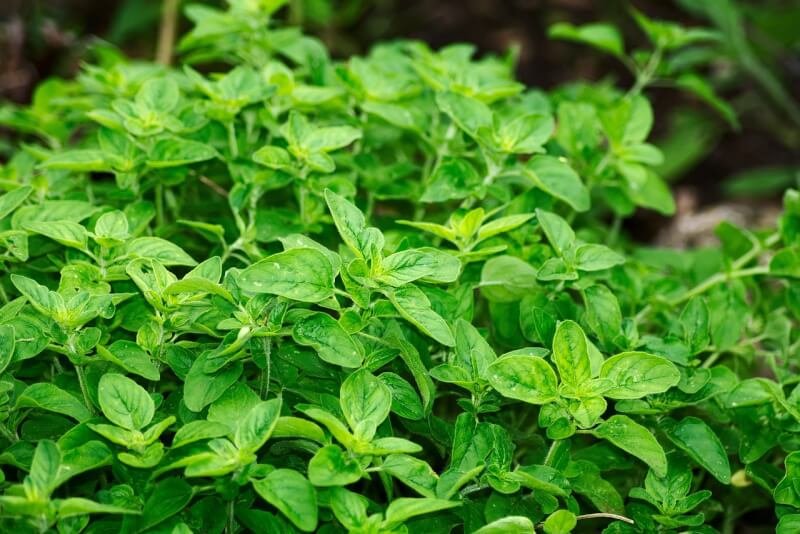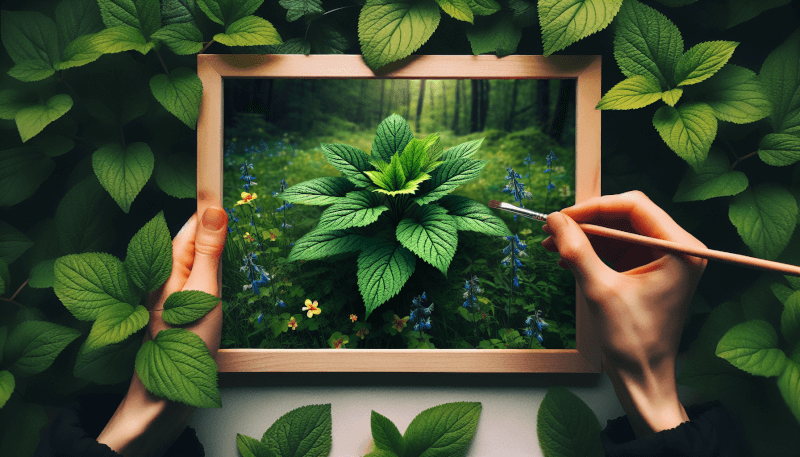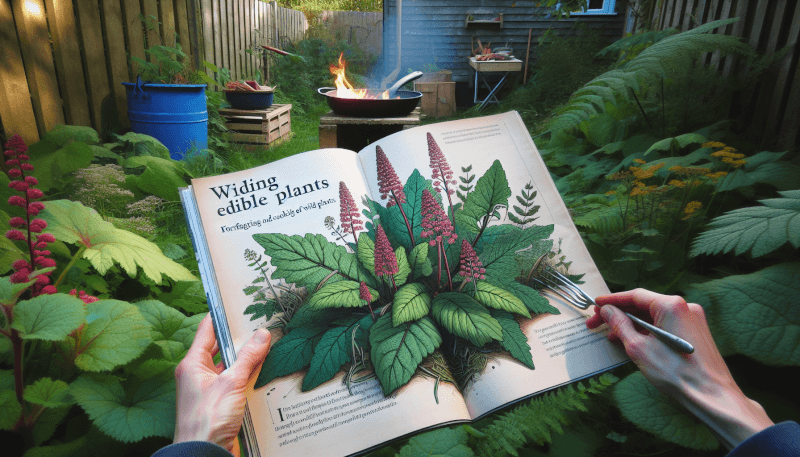You’re about to embark on a fascinating journey into the world of edible wild plants. In this article, we’ll explore the wonders of nature’s bounty and how to prepare these treasures for a delicious meal. From the thrill of foraging in the great outdoors to the art of transforming wild plants into culinary delights, this guide will equip you with the knowledge and skills to confidently explore this gastronomic adventure. So, fasten your seatbelts and get ready to discover the secret world of edible wild plants and the joy of preparing them.
Identification of Edible Wild Plants
Importance of proper identification
Proper identification of edible wild plants is of utmost importance to ensure your safety and well-being. Identifying wild plants accurately is essential in distinguishing between the edible ones and potentially harmful or poisonous ones. Without proper identification, you risk consuming plants that may be toxic or can cause allergic reactions. Therefore, it is crucial to learn about plant characteristics, such as leaves, flowers, fruits, and growth habits, to accurately identify the edible ones.
Best resources for plant identification
To aid in the identification of edible wild plants, there are various resources available that can be valuable tools in your foraging journey. Field guides specific to your region are an excellent starting point. Look for guides that include clear photographs or detailed illustrations of the plants, along with descriptions of their identifying features and habitat. Online resources, such as reputable websites and plant identification forums, can also be helpful in confirming your findings or seeking expert advice. Consider attending workshops, foraging classes, or joining nature clubs to learn firsthand from experienced foragers in your area.
Common edible wild plants to know
Before venturing into the world of foraging, it is beneficial to familiarize yourself with some common edible wild plants that are relatively easy to identify and widely available. Some examples include wild blackberries, dandelion greens, lamb’s quarters, nettles, purslane, and chickweed. These plants are not only abundant in many regions but also offer a range of flavors and nutrients. By learning about these common edible wild plants, you can gain confidence in your foraging abilities and gradually expand your knowledge and repertoire of wild edibles.
Foraging Ethics and Safety
Responsible foraging practices
Foraging ethics play a crucial role in preserving the delicate balance of nature while enjoying the benefits of wild edibles. When foraging, it is essential to respect the land and its inhabitants. Only harvest plants that you will use, leaving behind enough to ensure their sustainability and the ecosystem’s biodiversity. Avoid foraging in protected areas, private properties, or areas with endangered species. Always follow regulations, permits, or guidelines set by local authorities or landowners. By adhering to responsible foraging practices, you can ensure the continued abundance of edible wild plants for yourself and future foragers.
Conservation and sustainable harvesting
Sustainable harvesting is integral to the long-term survival of edible wild plants. To minimize the impact on their populations and their habitats, adopt sustainable harvesting practices. Avoid over-harvesting by only taking what you need and leaving behind enough plants for natural regeneration. Focus on harvesting invasive or abundant species rather than rare or endangered ones. Additionally, learn about the life cycles and growth patterns of the plants you forage to ensure you harvest them at the right time, allowing them to reproduce and thrive.
Safety considerations when foraging
While foraging for wild edibles can be an enriching experience, it is essential to prioritize your safety. Some safety considerations to keep in mind include:
- Familiarize yourself with poisonous plants and learn to differentiate them from edible ones.
- Wear appropriate clothing, including long sleeves, pants, and sturdy shoes, to protect against cuts, scratches, and insect bites.
- Be cautious of areas where pesticide or chemical use is prevalent, such as agricultural fields or roadside ditches.
- Take precautions against ticks, such as using repellents, wearing light-colored clothing, and conducting tick checks after your foraging excursion.
- Stay hydrated, bring necessary supplies like sunscreen and insect repellent, and be aware of any potential allergens that may be present in the environment.
By taking these safety considerations into account, you can ensure a pleasant and secure foraging experience.

Basic Foraging Tools and Equipment
Essential tools for foraging
While foraging can be done with minimal equipment, having a few essential tools can greatly enhance your efficiency and safety. Some essential tools for foraging include:
- Hand pruners or scissors for easy cutting and harvesting.
- A sturdy knife for cutting woody stems, digging roots, or preparing plants for consumption.
- A foraging basket or bag to safely transport your harvest.
- Gloves to protect your hands from thorns, irritant plants, or potential allergens.
- A field notebook and pen for jotting down observations and recording locations to revisit in the future.
Having these basic tools readily available will make your foraging trips more enjoyable and productive.
Special equipment for specific plants
In addition to the essential tools, some special equipment may be required for certain plants or specific foraging techniques. For example, if you plan to harvest mushrooms, a foraging knife with a brush or a mushroom foraging basket can be useful for gently removing dirt and debris without damaging the delicate fungi. Similarly, a digging tool, such as a hori hori or a small hand trowel, may be necessary when harvesting root vegetables like wild yams or fiddlehead ferns. Depending on the plants you intend to forage, research and acquire the appropriate special equipment to ensure a successful and efficient harvest.
Field guides and reference books
Field guides and reference books are invaluable resources for foragers, providing detailed information and visual aids for plant identification. Invest in high-quality field guides specific to your region or the type of wild edibles you wish to forage. Look for guides that include clear photographs, botanical illustrations, or detailed descriptions of the plants’ characteristics and habitats. In addition to field guides, consider collecting reference books that delve deeper into the culinary or medicinal uses of wild plants. These resources can expand your foraging knowledge and inspire creativity in the kitchen.
Preparing Wild Plants for Consumption
Cleaning and washing techniques
Properly cleaning and washing wild plants is crucial to remove any dirt, insects, or other contaminants. Start by rinsing your harvest under cold running water, gently rubbing the leaves or stems to dislodge any debris. If necessary, soak the plants in cold water for a few minutes to further loosen any stubborn dirt. Avoid soaking delicate greens or herbs for an extended period, as it may affect their texture and flavor. Once clean, pat the plants dry using a clean kitchen towel or salad spinner to remove excess moisture before using them in your culinary creations.
Removing unwanted parts
Some wild edible plants may have specific parts that need to be removed or prepared differently to enhance their flavor or mitigate any potential toxins. For instance, with certain wild mushrooms, it is essential to remove the tough stems or peel the outer skins before cooking. Similarly, when foraging for certain greens like dandelion, it is advisable to trim off any tough or bitter portions of the leaves. It is essential to consult reliable resources or experienced foragers to understand which parts should be discarded or modified for each specific plant to ensure optimal taste and safety.
Dealing with toxicity and allergens
While most wild edible plants are safe for consumption, there are exceptions. Some plants may contain toxins or allergens that need to be addressed before consuming. For instance, some wild berries may require cooking to neutralize certain toxins. Additionally, individuals with known allergies or sensitivities should exercise caution when foraging and consuming wild plants, as some may elicit adverse reactions. If you are uncertain about the safety of a particular plant or have any concerns about potential toxicity or allergens, it is advisable to consult reliable resources, experienced foragers, or even seek professional medical advice.

Cooking Techniques for Wild Plants
Blanching and boiling
Blanching and boiling are versatile cooking techniques that can be used to prepare a wide range of wild plants. Blanching involves briefly immersing the plants in boiling water and then rapidly cooling them in ice water to retain their vibrant color, texture, and nutrients. This technique is particularly useful for delicate greens, such as stinging nettle or wild ramps. Boiling, on the other hand, involves fully cooking the wild plants in boiling water until tender. This method is ideal for tougher greens or root vegetables like wild asparagus or burdock root.
Sautéing and stir-frying
Sautéing and stir-frying are quick and flavorful cooking methods that allow you to preserve the natural taste and texture of wild plants. Heat a small amount of oil or butter in a skillet over medium-high heat, then add your cleaned and prepared wild plants. Stir continuously for a few minutes until the plants are wilted or tender. Season with salt, pepper, or herbs according to your taste preferences. Sautéed or stir-fried wild plants, such as dandelion greens or wild mushrooms, make excellent additions to pasta dishes, omelets, or as a side dish.
Baking and roasting
Baking and roasting are fantastic techniques to highlight the unique flavors and textures of certain wild edibles. Preheat your oven and arrange your cleaned and seasoned wild plants on a baking sheet. Drizzle with olive oil and roast at a moderate temperature until they are slightly crispy or caramelized. Baking or roasting wild plants like fiddlehead ferns or wild onions imparts a wonderful smoky or nutty taste, making them perfect for pizzas, vegetable medleys, or as flavorful toppings for various dishes.
Steaming and grilling
Steaming and grilling are gentle cooking methods that allow the natural flavors of wild plants to shine through. To steam, place cleaned wild plants in a steamer basket or a colander set over simmering water. Cover and cook until tender but still vibrant. Grilling wild plants involves placing them directly on a preheated grill or grilling pan over medium heat. Cook until charred and slightly softened. Steamed or grilled wild plants, such as wild asparagus or fiddlehead ferns, make delightful accompaniments to main dishes or can be enjoyed as a standalone side dish.
Methods of Preserving Wild Edibles
Drying and dehydration
Drying and dehydration are traditional methods of preserving wild edibles for long-term storage. Choose plants without high water content, such as mushrooms, herbs, or berries, for optimal drying results. To dry wild plants, spread them in a single layer on a clean, dry surface or use a food dehydrator. Ensure good airflow and proper ventilation throughout the drying process to prevent mold or spoilage. Once the plants are thoroughly dry and brittle, store them in airtight containers in a cool, dark place. Dried wild plants can be used in teas, infused oils, or rehydrated for cooking.
Freezing and canning
Freezing and canning are effective techniques for preserving the freshness and flavors of wild edibles. For freezing, blanch or cook the wild plants briefly to preserve their color and texture. Once cooled, pack them in airtight containers or freezer bags and store in the freezer. Canning involves packing the prepared wild plants into sterilized jars with appropriate liquids, such as brine or syrup, and sealing them for long-term shelf stability. Freezing and canning allow you to enjoy the flavors of wild plants throughout the year, even when they are out of season.
Fermentation and pickling
Fermentation and pickling are unique preservation methods that not only extend the shelf life of wild edibles but also enhance their flavors and nutritional profiles. Fermentation involves allowing beneficial bacteria to break down sugars in the plants, resulting in tangy and probiotic-rich products. To ferment wild plants, submerge them in a brine solution or pack them into fermentation containers. Pickling, on the other hand, involves preserving the wild plants in a mixture of vinegar, spices, and sometimes sugar. The acidic environment imparts a pleasantly tart taste to the preserved plants. Fermented or pickled wild plants, such as wild cucumbers or garlic scapes, make excellent additions to salads, sandwiches, or charcuterie boards.

Creating Wild Edible Recipes
Incorporating wild plants into meals
Incorporating wild plants into your meals is a wonderful way to explore new flavors and add nutritional diversity to your diet. Start by incorporating small amounts of foraged wild plants into familiar recipes. Add sautéed wild mushrooms to pasta dishes, toss wild greens in salads, or use wild berries in desserts. As you gain confidence and experience, expand your culinary repertoire by experimenting with more unique recipes that showcase the flavors and textures of wild edibles. Get creative with wild plant pestos, dips, soups, or even incorporate them into baked goods like muffins or pies.
Experimenting with flavors and textures
Foraging for wild plants offers an opportunity to explore a world of diverse flavors and textures. Experiment with combining different wild plants to create unique flavor profiles. For instance, mix wild ramps with nettles for a savory and earthy pesto or blend tangy sorrel leaves with delicate wild violets for a refreshing spring salad. Enhance the flavors of your wild creations by incorporating complementary herbs, spices, or ingredients from your garden or pantry. The more you experiment, the more you will discover the limitless culinary possibilities that wild edibles can offer.
Sharing and documenting recipes
Foraging and cooking with wild edibles is an enjoyable experience that should be shared and documented. Share your newfound culinary creations with friends, family, or fellow foragers. Host a wild plant-themed dinner or potluck to exchange recipes and stories. Consider starting a foraging journal or a blog to document your foraging adventures, recipes, and lessons learned. By sharing and documenting recipes, you not only inspire others to forage and explore the world of wild edibles but also create a lasting record of your own culinary journey.
Nutritional Value and Health Benefits
Rich sources of vitamins and minerals
Wild edibles can be a valuable source of essential vitamins, minerals, and other nutrients. Many wild plants are packed with vitamins A, C, and K, as well as minerals like calcium, iron, and potassium. For example, dandelion greens are incredibly nutrient-dense, containing higher levels of vitamin A and calcium than most cultivated greens. Nettles are rich in iron and vitamin C, making them a nutritious addition to your meals. By incorporating wild edibles into your diet, you can enjoy a diverse range of nutrients that may not be as abundant in store-bought produce.
Potential medicinal properties
For centuries, various wild plants have been used in traditional medicine for their potential healing properties. While it is essential to consult experts or reliable resources before using wild plants for medicinal purposes, some plants have documented medicinal uses. For instance, elderberries are known to have immune-boosting properties and can be made into syrup or tincture to help alleviate common cold symptoms. Stinging nettle has been used to alleviate allergies and inflammation. It is crucial to research and study plants thoroughly, as well as consult medical professionals, before utilizing wild edibles for their potential medicinal benefits.
Considerations for special diets or allergies
When incorporating wild edibles into your diet, it is essential to consider any specific dietary needs or allergies. Some wild plants may interact with certain medications, or individuals with underlying health conditions may need to exercise caution when consuming particular plants. Additionally, individuals with known allergies or sensitivities should be vigilant, as wild plants may trigger similar reactions. It is always advisable to start with small quantities of any new plant, carefully observe any potential side effects, and consult with a healthcare professional if you have any concerns.

Common Mistakes to Avoid
Misidentification and toxic plants
One of the most significant risks when foraging for wild plants is misidentification, which can lead to consuming toxic or poisonous plants. The consequences can range from mild discomfort to severe illness or even death. Therefore, it is vital to take the time to accurately identify the plants you forage, especially if you are not familiar with them. Rely on reputable resources, field guides, and expert advice to ensure your safety. Do not rely solely on visual cues; learn to recognize distinguishing characteristics of each plant and cross-reference multiple sources for confirmation.
Over-harvesting and environmental impact
Over-harvesting can have severe consequences on the sustainability of wild plant populations and their ecosystems. It is essential to forage responsibly and only take what you need. Never strip an area of all its edible plants. Instead, adopt the “leave no trace” principle and harvest in moderation to allow plants to reproduce and replenish their numbers. Be particularly cautious when harvesting rare or endangered species and abide by regulations set to protect such plants. By practicing sustainability, you can contribute to the preservation of wild edibles for future generations.
Improper processing or cooking
Improper processing or cooking of wild plants can diminish their flavors, textures, and nutritional value, or even render them unsafe for consumption. Some wild plants contain toxins or are indigestible when eaten raw. Understanding the appropriate processing techniques, such as blanching, boiling, or removing specific parts, is crucial to unlock their full potential. Always research and follow reliable recipes or methods for each wild plant you intend to cook with. By adhering to proper processing and cooking techniques, you can ensure the best end result and enjoy the flavors of wild edibles safely.
Precautions and Warnings
Consulting with experts
When entering the world of foraging, it is essential to seek guidance and knowledge from experts or experienced foragers. Learn from those who have spent years studying and safely harvesting wild plants. Seek their assistance in identifying plants, understanding their properties and potential hazards, and learning sustainable foraging practices. Regularly attend foraging classes, workshops, or guided tours to expand your knowledge and skills. Remember, even seasoned foragers continually educate themselves to stay safe and make informed decisions.
Testing for allergies or sensitivities
Prior to consuming any new edible plant, it is vital to recognize any potential allergies or sensitivities you may have. Perform a small skin patch test by rubbing a part of the plant on your inner wrist or forearm and closely monitoring any reactions for a period of time. If no adverse reactions occur, cautiously introduce a small amount of the plant into your diet and observe for any gastrointestinal or allergic symptoms. If you have a history of allergies or sensitivities or are unsure about incorporating a particular plant into your diet, consult a healthcare professional before consuming it.
Avoiding contaminated areas
When foraging, it is crucial to be mindful of the areas in which you gather your wild plants. Avoid foraging in areas that may be contaminated with pollutants, such as heavy metals, pesticides, or chemicals. Steer clear of roadsides, industrial areas, or agricultural fields where pesticide or herbicide use is prevalent. Forage in safe, natural environments that are less likely to harbor contaminants. It is equally important to wash your foraged plants thoroughly and practice good hygiene before consuming them to minimize any potential risks.
By following these precautions and warnings, you can ensure a safe and enjoyable foraging experience, protecting both your well-being and the environment. Remember, the world of wild edibles is vast and diverse, offering countless opportunities for exploration and culinary delight, but always prioritize safety and responsibility when engaging in this enriching activity.



